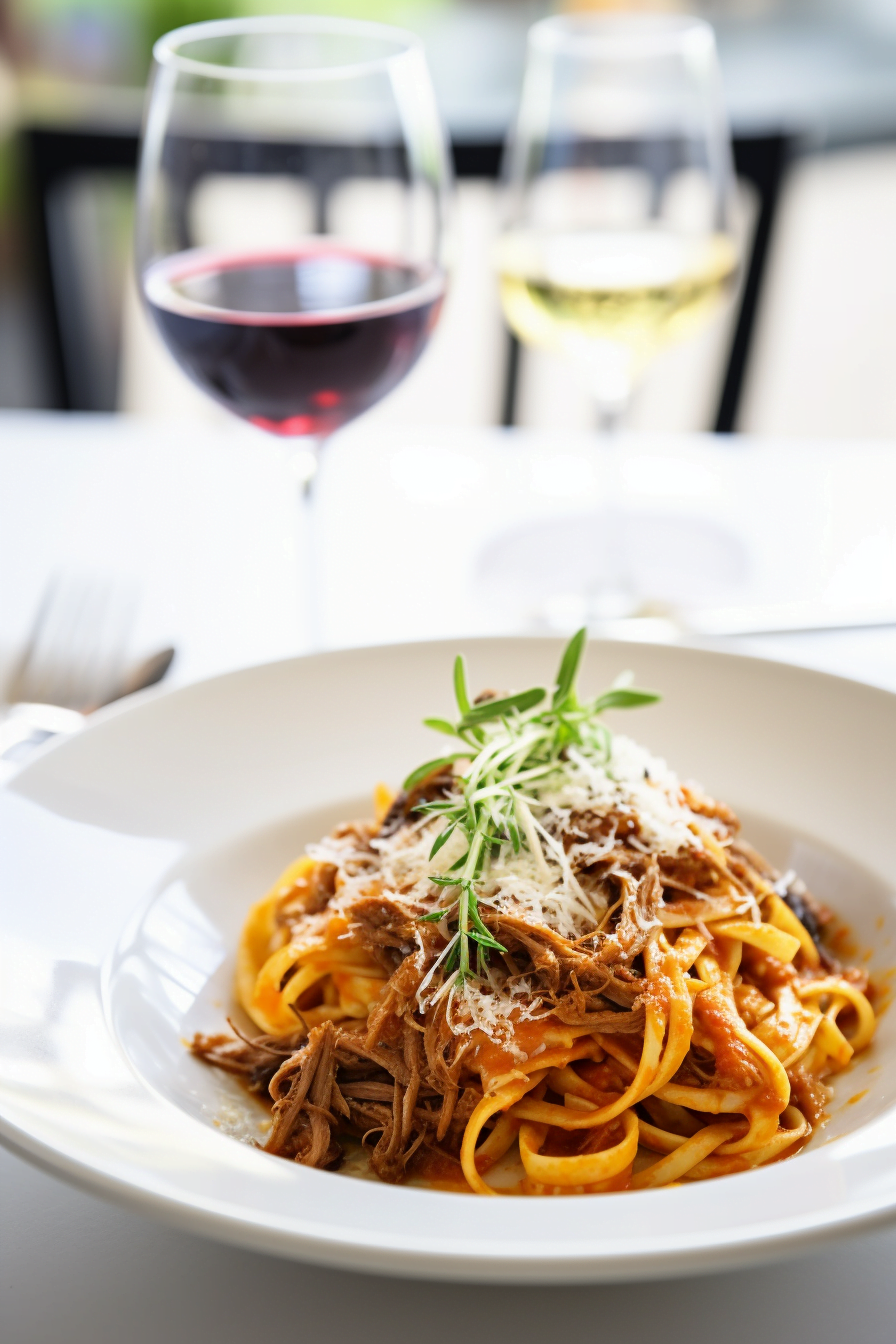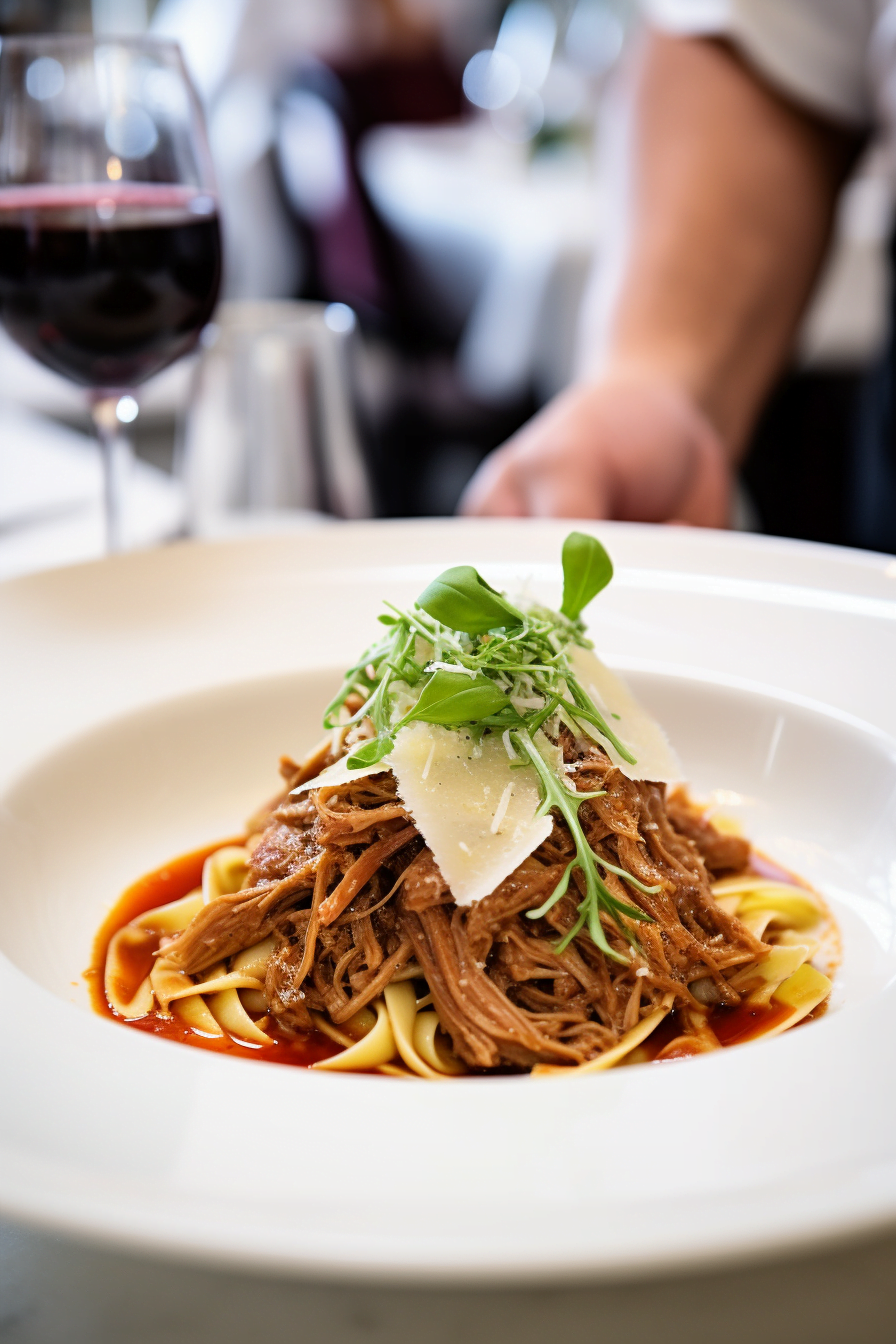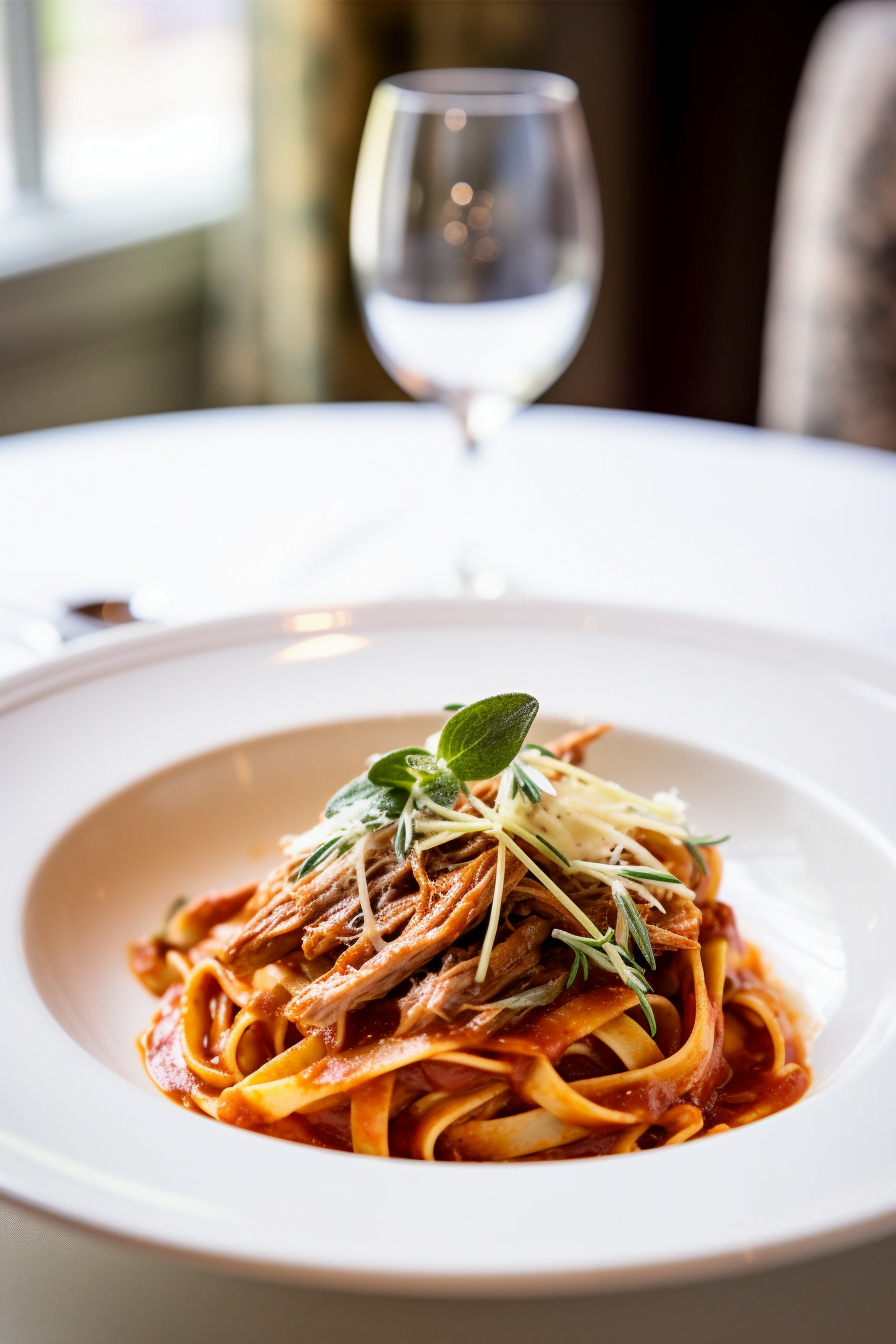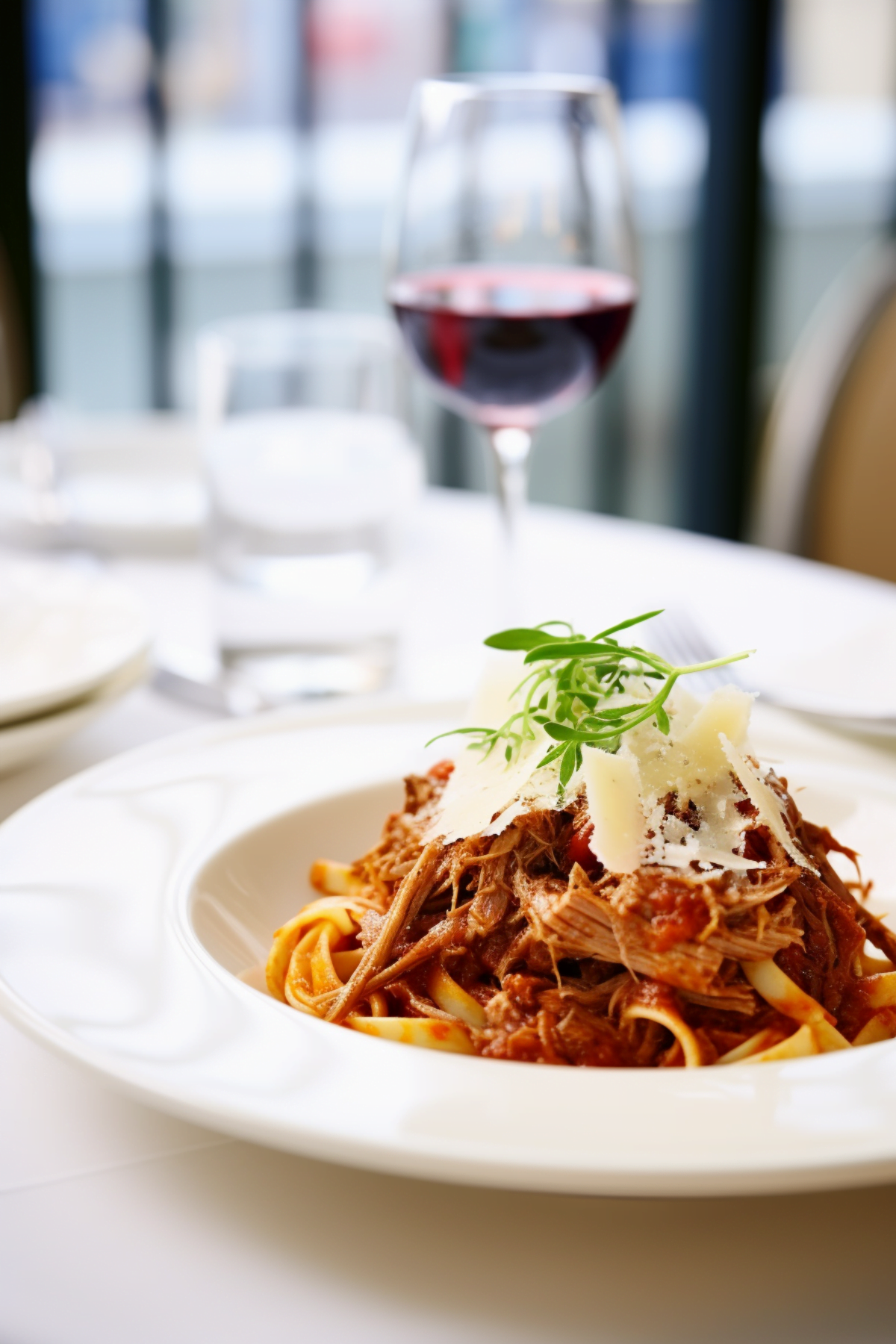Indulge in the Essence of Venice with a Classic Duck Ragu
Imagine the gondolas gliding through the serene canals of Venice as you savor the rich and hearty flavors of a classic Venetian Duck Ragu. This luxurious dish, served over the traditional Bigoli pasta, is more than just a meal; it’s a passage to the heart of Italian culinary excellence. Perfect for a sophisticated dinner, the combination of tender duck and robust sauce promises a dining experience that’s both sumptuous and authentically Venetian.
Whether you’re an experienced cook or a passionate foodie, this recipe will guide you through creating a masterpiece that celebrates the simplicity and depth of flavors that Venetian cuisine has to offer. So, tie on your apron, and let’s embark on a culinary journey to the waterways of La Serenissima with this exquisite Venetian Duck Ragu with Bigoli Pasta.

The Story Behind Venetian Duck Ragu
The Venetian Duck Ragu is a dish steeped in history, hailing from the region of Veneto, where the blend of local ingredients and centuries-old techniques creates a tapestry of flavors unique to the lagoon city of Venice. The use of duck in this recipe is a nod to the game that was historically abundant in the Venetian countryside, making it a staple for many local dishes.
This particular ragu is a testament to the Venetian love for slow-cooked meats, where the duck is braised to perfection, absorbing the rich flavors of the wine and herbs. The Bigoli pasta, a thicker variant of spaghetti traditionally made with whole wheat flour, is the perfect companion to the robust sauce, its dense texture holding up against the weight of the ragu.
The Venetian Duck Ragu is not just a dish; it’s a celebration of the region’s gastronomic legacy. It’s a dish that tells the story of Venice, a city that has long thrived on its trade in spices and culinary influences from across the globe. The ragu’s deep, complex flavors are a testament to the city’s history as a melting pot of cultures, making it a beloved classic in Venetian cuisine.

The Art of Crafting the Perfect Venetian Duck Ragu
The secret to a sublime Venetian Duck Ragu lies in the slow cooking process, which allows the flavors to meld and intensify. When searing the duck, aim for a crisp, golden-brown skin that will impart a rich flavor to the sauce. Be patient and let the skin render its fat slowly, which not only adds depth to the dish but also creates a succulent texture in the meat.
As the vegetables sauté, they should soften and become a fragrant base for the ragu. The key here is to cook them until they’re just beginning to caramelize, unlocking a sweetness that balances the savory duck. When deglazing with red wine, ensure that you scrape up all the delicious browned bits from the bottom of the pot, as they are flavor goldmines.
The long simmer is where the magic happens. The duck should be so tender that it falls off the bone with minimal effort, and the sauce should be thick and rich. If you find the sauce reducing too quickly, don’t hesitate to add a splash more stock to keep it at the right consistency. And remember, when combining the pasta with the ragu, the pasta should be al dente to stand up to the hearty sauce without becoming mushy.

Variation: Duck Ragu with Pappardelle
If Bigoli pasta is not readily available, a wonderful alternative is pappardelle. The broad, flat ribbons of pappardelle make an excellent substitute, as they provide ample surface area for the rich duck ragu to cling to, ensuring each bite is as flavorful as the last.
Variation: Venetian Duck Ragu with Polenta
For a gluten-free option, serve the ragu over a bed of creamy polenta. The soft, comforting texture of polenta complements the hearty ragu, creating a delightful contrast that’s sure to please the palate.
Variation: Venetian Duck Ragu with Root Vegetables
Incorporate chunks of root vegetables such as parsnips or turnips into the ragu for an added layer of earthiness and a boost of nutrition. These vegetables will absorb the sauce’s flavors and add a rustic touch to the dish.
Substitutions for a Tailored Culinary Experience
While the traditional ingredients of the Venetian Duck Ragu are irreplaceable, certain substitutions can be made to accommodate dietary preferences or availability of ingredients.
For those who do not consume alcohol, the red wine can be replaced with a combination of red grape juice and a splash of red wine vinegar to mimic the acidity and depth of flavor that wine imparts.
Should duck legs be difficult to source, chicken thighs make a suitable alternative. They are similarly rich in flavor and possess enough fat to ensure the sauce remains luscious and full-bodied.
For a dairy-free version of the dish, omit the Parmesan cheese or replace it with a dairy-free alternative that can provide a similar salty, umami kick to finish the dish.
Frequently Asked Questions
Can I make the ragu ahead of time?
Yes, the flavors of the ragu actually improve with time, making it an excellent make-ahead dish. Simply prepare the ragu, let it cool, and store it in the refrigerator for up to 3 days. Reheat gently before serving.
Is there a specific type of red wine that works best for this recipe?
A full-bodied red wine like Valpolicella or Amarone is ideal, as it complements the richness of the duck. However, any good quality dry red wine that you enjoy drinking will work well.
Can I use dried herbs instead of fresh?
While fresh herbs offer the best flavor, dried herbs can be used in a pinch. The general rule of thumb is to use one-third the amount of dried herbs compared to fresh.
How do I know when the duck is cooked perfectly?
The duck is ready when it is tender enough to easily pull away from the bone. This typically takes 1.5 to 2 hours of simmering on low heat.
What if I can’t find Bigoli pasta?
Bigoli can be substituted with other thick, long pastas like bucatini or even homemade tagliatelle. The goal is to use a pasta that can stand up to the weight of the ragu.

Venetian Duck Ragu with Bigoli Pasta
Equipment
- Dutch oven
- pasta maker or rolling pin
- Large pot
- Sharp knife
- Wooden spoon
- Tongs
- Cheese grater
Ingredients
- 4 Duck legs (about 2 lbs or 900 g)
- 1 lb Bigoli pasta (450 g)
- 1 large Onion finely chopped
- 2 medium Carrots diced (about 1 cup or 130 g)
- 2 Celery stalks diced (about 1 cup or 110 g)
- 3 Garlic cloves minced
- 1 cup Red wine (240 ml)
- 28 oz Canned tomatoes crushed (800 g)
- 2 cups Chicken stock (480 ml)
- 1 sprig Fresh rosemary
- 1 sprig Fresh thyme
- 1 Bay leaf
- 2 tablespoons Olive oil (30 ml)
- Salt and freshly ground black pepper to taste
- Grated Parmesan cheese for serving
Instructions
- Season the duck legs with salt and pepper. In a Dutch oven, heat the olive oil over medium-high heat. Add the duck legs, skin-side down, and sear until the skin is golden brown, about 5 minutes per side. Remove the duck and set aside.
- In the same pot, add the onions, carrots, and celery. Cook over medium heat until the vegetables are softened, about 5 minutes. Stir in the garlic and cook for another minute.
- Pour in the red wine, scraping the bottom of the pot to loosen any browned bits. Allow to reduce by half, then add the crushed tomatoes and chicken stock. Return the duck legs to the pot, and add the rosemary, thyme, and bay leaf. Bring to a simmer, then reduce the heat to low, cover, and cook for 1.5 to 2 hours, or until the duck meat is tender and easily pulls away from the bone.
- Remove the duck from the pot and let cool slightly. Discard the skin and bones, and shred the meat using two forks. Return the shredded duck to the pot and stir into the sauce. Season with additional salt and pepper to taste.
- Bring a large pot of salted water to a boil. Cook the Bigoli pasta according to package instructions until al dente. Drain, reserving a cup of pasta water.
- Add the cooked Bigoli to the ragu, tossing to coat the pasta evenly. If the sauce is too thick, add a bit of the reserved pasta water to reach the desired consistency.
- Plate the pasta and ladle generous amounts of duck ragu over the top. Finish with a sprinkle of grated Parmesan cheese and serve immediately.
Notes

